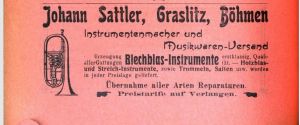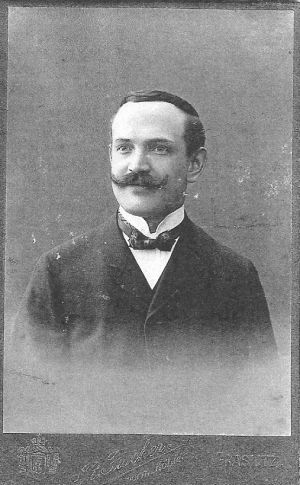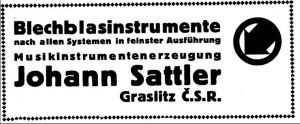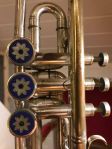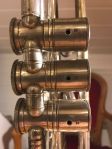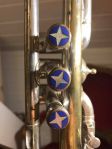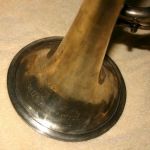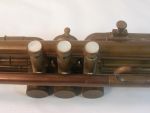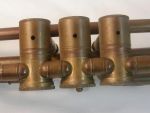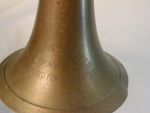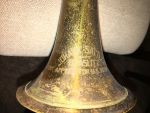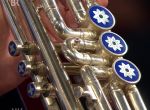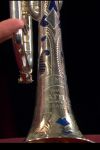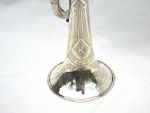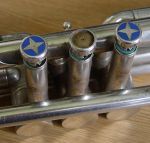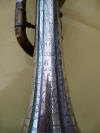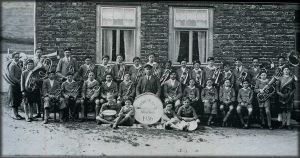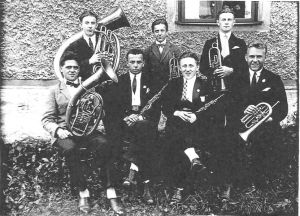Difference between revisions of "Johann Sattler"
Gwesterhof (talk | contribs) m (→Star Supertone) |
Gwesterhof (talk | contribs) m (→Star Supertone) |
||
| Line 88: | Line 88: | ||
This instrument was sold in 2012 by Felicity Blastland, Swansea, UK, who got it in 1981 from a friend. His father, captain E.J. (Eric) Farmery, had owned it. Farmery was born in the late 1920’s and came from Selby in Yorkshire, UK. He was a jazz enthusiast and loved playing it. It's unclear where he picked up the horn, in the 1950's he was posted in Stuttgart, India and Singapore, so it probably went out there with him. | This instrument was sold in 2012 by Felicity Blastland, Swansea, UK, who got it in 1981 from a friend. His father, captain E.J. (Eric) Farmery, had owned it. Farmery was born in the late 1920’s and came from Selby in Yorkshire, UK. He was a jazz enthusiast and loved playing it. It's unclear where he picked up the horn, in the 1950's he was posted in Stuttgart, India and Singapore, so it probably went out there with him. | ||
| + | |||
The Edinburgh museum has an instrument without a makers name but on the bell the Czech CZ 6296-35 and US 2,106,281 patents engraved and also the Made in Czechoslovakia on the reciever ferrule, with serial number 130. The picture is mirrored. | The Edinburgh museum has an instrument without a makers name but on the bell the Czech CZ 6296-35 and US 2,106,281 patents engraved and also the Made in Czechoslovakia on the reciever ferrule, with serial number 130. The picture is mirrored. | ||
[[File:Sattler no name Edinburgh.jpg|thumb|center|<small>sr. nr. 130 coll. University of Edinburgh</small>]] | [[File:Sattler no name Edinburgh.jpg|thumb|center|<small>sr. nr. 130 coll. University of Edinburgh</small>]] | ||
Revision as of 17:06, 17 July 2019
Johann Sattler, Graslitz, Czechoslovakia
Johann Sattler was a brass instrument maker in Graslitz. He was born in Graslitz in 1878, his father being Anton Sattler. In his workbook he is described as big, blue eyes, catholic (like most of the Graslitz people). Johann started at the age of 13 as a pupil at J.B. Gessner (Silberbacherstrasse 728, Graslitz, founded in 1870 by Johann Baptist Gessner). He worked there from August 15th 1891 till November 1st 1896. Then he went for two years and 5 months to Christian Reisser Instrumentenfabrik in Ulm, Germany, till March 6th 1899. From December 2nd 1902 - May 30 1907 he's enlisted again at J.B. Gessner. And from June 9th 1907 - June 30th 1910 we find him at Franz Michl, Graslitz. All these dates were confirmed by the Genossenschaft der Instrumentenmacher Graslitz on August 17th 2010, after his last period with Franz Michl. According to Gunther Dullat he established his own workshop in 1904, which seems a bit strange considering the above dates. In 1912 he is mentioned in the Almanac of the Austrian Clergy as supplier of the reverend clergy, along with J.B.Gessner, Franz Michl and 14 other musical instrument makers from Graslitz.
In 1914 Sattler served in the Austrian Hungarian Army (the 6th Landsturm Regiment, a reserve force consisting of men aged 34 to 55). Around 1938 he was located at the address Silberbacherstrasse 23. He was also active in the trade of musical instruments and strings.
Johann Sattler patented a trumpet with push-rods enclosed in metal tubes in Czechoslovakia, on November 1st, 1935, no. CZ 6296 - 35. He also patented this invention in the US (US 2,106,281 by Johann Sattler of Bohemia, Czechoslovakia), filed on August 15th, 1936 and approved on January 25th,1938. In his patent he claims that opening the valves only requires a very small movement of the plungers and therefore his invention permits quicker tone variations.
The Fiske Museum collection has another tarv trumpet by Johann Sattler, Graslitz, marked 'Patent Pending U.S.A.' (ca. 1937).
On September 22th 2018 the granddaughter of Johann Sattler showed in a broadcast of the Bavarian BR a Sattler JAZZMASTER which according to her was his masterpiece. It has blue and pearl valve tops and similar caps and extensive multi coloured art deco engravings. It was dated around 1910 by the experts on duty. Which would be in line with the age of Sattler by then and his period as a pupil, but not with the use of the Jazzmaster name, because the use of the word jazz really started later....
At an auction in Vichy (France) in 2007 a Sattler, Graslitz JAZZ MASTER trumpet was sold with similar blue and pearl valve tops. In november 2015 Jan Vundr ('Brass maniac') also sold a Jazzmaster that looked identical to the Sattlers, but with no other engravings than Jazzmaster (and without blue and pearls valve tops).
Jazzmaster source: Brassmaniac.com 2015
Star Supertone
Star Supertone serial number 137, coll. Gerard Westerhof
Practically identical is a trumpet marked Star Supertone with a 'K' in an art deco engraving. The bell rim mentions the Sattler U.S. and Č.S.R patents, on the reciever is 'Made in Czechoslovakia' engraved and a serial number 137. The valve caps have a blue star inlay in mother of pearl like the Sattler masterpiece above. Supertone was one of the tradenames used by Sears for their musical instruments, but the combination Star Supertone along with the K in the logo is unique sofar. Because of this K, my hypothesis is that the instrument might have been made by Sattler and sold by V. Kohlert and Sons from Graslitz, who is known to have made other 'Star' instruments for the American market, and sold in the US through Sears. But that's only a wild guess.
This instrument was sold in 2012 by Felicity Blastland, Swansea, UK, who got it in 1981 from a friend. His father, captain E.J. (Eric) Farmery, had owned it. Farmery was born in the late 1920’s and came from Selby in Yorkshire, UK. He was a jazz enthusiast and loved playing it. It's unclear where he picked up the horn, in the 1950's he was posted in Stuttgart, India and Singapore, so it probably went out there with him.
The Edinburgh museum has an instrument without a makers name but on the bell the Czech CZ 6296-35 and US 2,106,281 patents engraved and also the Made in Czechoslovakia on the reciever ferrule, with serial number 130. The picture is mirrored.
Johann Sattler, Graslitz, source Ebay.com (US) 2018
Johann Sattler also made a one-valve one. Missing the valve cap and inscribed Patent applied for U.S. Patent Office. It is 22" long and the bell is approximately 4 3/8" diameter.
And he applied the technique to a tuba as well. This tuba is in the Hartenberger World Music Collection, through Dr. Paul & Ernestine Kirk via Alfred H. Hicks Collection. It alsop says Patent applied for U.S. Patent Office. HWMC calls it Berliner valves, which is not correct.
Johann Sattler , tuba with piston/rotary valves
Kielbich & Sattler
Julian Kielbich & Johann Sattler, source Ebay.
Sattler marketed his invention not only in the U.S. The model is found with both the name Julian Kielbich, an instrument trader from the Polish town of Bydgoszcz and Johann Sattler, Graslitz engraved. Bydgoszcz is a city in the northwest of Poland. It was German and named Bromberg until 1920 and during WWII. This trumpet says P.A. 6296, which I believe means 'Patent angefragt' (patent pending), referring to the Czech patent that was granted in 1935.
Sattler applied the same patent to the tuba, of which an example is in the Hartenberger World Music Collection.
Here's a picture of the Musikschule Johann Sattler (Raschpl), in the Pächer-Wirtshaus, in Hof, Graslitz, 1936. Not sure if it's the same Johann Sattler....
There are just a very few other instruments known of Sattler. This is a rotary valve trumpet. Joh.Sattler, Graslitz
And here's a french horn (Waldhorn), Johann Sattler Musikinstrumenten Fabrik Graslitz
Johann Sattler died on November 13th 1944, aged 66. The company was shut down after the death of Johann because his son and the other worker both were drafted into the German army. Before that Sattler had 10 people at work and a bookkeeper. They all had to go into the army. His inheritance was divided between his widow Julie and the children Franz, Berta, Marie and Franziska. Franz was instrument maker and the intended successor, he inherited the workshop tools, three old lathes, three workbenches and the smaller tools. Total value by then: RM 2.200. Julie and the children divided the rest of the inheritance, RM 8.100 and RM 200 clothes and linen. Sadly Franz, who was in the army as Stabsgefreiter (a specialist rank) in Beroun near Prague, fell at the end of the war.
On the certificate of inheritance, dated March 9th 1945, Julie, Berta and Franziska are registered at the adress Graslitz 23, the Silberbacherstrasse, although Berta is married to professor (Anton?) Ernstberger. Marie is living/working as a hostess at 5.kvetna 316 in Graslitz (now restaurace ČERVENÝ MLÝN). (the other son Gerhard died in the war earlier).
In May 1945 the company was taken over by the Amati coöperative, with all the paperwork and balance sheets.
On the list of expelled people in 1946 Julie (61) and Franzeska (26) are mentioned at this address and also Berta (35) with a note that her husband is in captivity and Marie (32) with her child Ulrike aged 2, still living at nr 316. They al go to Bavaria. There is a document to make an inventory of the damage of the expulsion (Vertriebungsschäden) that gives some more information about the Johann Sattler workshop. Workshop, packing room, warehouse, soldering room and office in the Silberbachstrasse 23. The building is said to be constructed in 1929. The inventories consisted of the usual equipment of a wind instrument production facility including special machines, brass tubes, brass sheets, musical instruments, finished and semi-finished products / trombones, trumpets, basses, zithers, etc., in a value of approximately RM 8,000 - 10.000. There were no debts. The annual sales were not determinable anymore because the Amati coöperative also had claimed the paperwork and balance sheets. But some 40% consisted of export orders to the USA, Spain, Poland, Balkan and other states.
